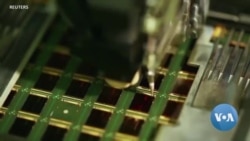U.S. President Joe Biden has signed the CHIPS and Science Act, which aims to boost U.S. competitiveness against China by allocating billions of dollars toward domestic semiconductor manufacturing and scientific research.
“The United States must lead the world in the production of these advanced chips. This law will do exactly that,” Biden said in remarks during the signing ceremony Tuesday. The president is recovering from COVID-19 and coughed repeatedly during his remarks.
He called the bipartisan legislation a “once in a generation investment” in the country and said it will create good jobs, grow the economy and protect U.S. national security.
Biden noted stiff competition with China in the chips industry. “It’s no wonder the Chinese Communist Party actively lobbied U.S. business against this bill,” he remarked.
Biden was joined on stage for the event by House Speaker Nancy Pelosi, Senate Majority Leader Charles Schumer, Commerce Secretary Gina Raimondo, and Joshua Aviv, CEO of Spark Charge, an electric vehicle charging network.
Schumer called the legislation the “largest investment in manufacturing science and innovation in decades” and thanked Republican Senator Todd Young for his partnership for over three years working on semiconductor-related legislation, beginning with what was then called the Endless Frontier Act.
The proposed act went through various iterations before it was passed as the $280 billion CHIPS and Science Act on a 243-187 vote in the House of Representatives and a 64-33 vote in the Senate in July.
Last year, a semiconductor shortage affected the supply of automobiles, electronic appliances and other goods, causing higher inflation globally and pummeling Biden's public approval rating among American voters.
Catching up in the chips race
The CHIPS Act includes $52 billion in incentives for domestic semiconductor production and research, as well as an investment tax credit for semiconductor manufacturing. Advocates say it will allow the U.S. to catch up in the global semiconductor manufacturing race currently dominated by China, Taiwan and South Korea.
Following the passage of the bill, the White House noted that Micron, a leading U.S. chip manufacturer, will announce a $40 billion plan to boost domestic chip production while Qualcomm and GlobalFoundries will unveil a $4.2 billion expansion of a chip plant in New York.
The U.S. share of global semiconductor manufacturing capacity has decreased from 37% in 1990 to 12% today, largely because other governments have offered manufacturing incentives and invested in research to strengthen domestic chipmaking capabilities, according to a state of the industry report by the Semiconductor Industry Association.
Now China accounts for 24% of the world's semiconductor production, followed by Taiwan at 21%, South Korea at 19% and Japan at 13%, the report said.
The CHIPS Act also includes $4.2 billion to fund defense initiatives and the U.S. mobile broadband market, particularly efforts to promote non-Chinese 5G equipment manufacturing.
Broadly, the legislation lays out a strategy for Washington as it aims for global technological and economic dominance – gaining production autonomy by leveraging allies, including South Korea and Japan and eliminating political dependencies on the global semiconductor supply chain.
That strategy puts the U.S. on a collision course with China, which also aims to be the global leader in semiconductors. In 2015, Beijing launched the Made in China 2025 project, which aimed to increase chip production from less than 10% of global demand at the time to 40% in 2020 and 70% in 2025.
The Taiwan factor
Taiwan — a self-governed island that Beijing claims to be its breakaway province — is the main producer of the world's most high-tech chips. It lies at the heart of the semiconductor showdown, the latest battlefront in the increasingly tense U.S.-China strategic rivalry.
Taiwan accounts for 92% of the global production of 10 nm or smaller semiconductors, essentially creating what some observers have characterized as a "silicon shield" that ensures American support in the event of a Chinese attack, as well as a deterrence against such a move.
In a visit to Taipei that angered Beijing earlier this month, U.S. House Speaker Nancy Pelosi met with Mark Liu, chairman of Taiwan Semiconductor Manufacturing Co., the world’s biggest chipmaker.
Pelosi delivered all but one Democratic vote in the House of Representatives for the CHIPS Act. “Mr. President with the stroke of your pen, America declares our economic independence,” she said in her remarks Tuesday. “We strengthen our national security, and we enhance our family's financial future.”
Following Pelosi’s Taiwan visit, Beijing halted key communication channels with Washington and conducted live-fire military drills, raining Dongfeng ballistic missiles into the waters near Taiwan’s eastern, southern, and northern coasts.
While most experts don’t believe a war over Taiwan is imminent, many fear a conflict there would disrupt semiconductor production and have disastrous effects on global manufacturing.









